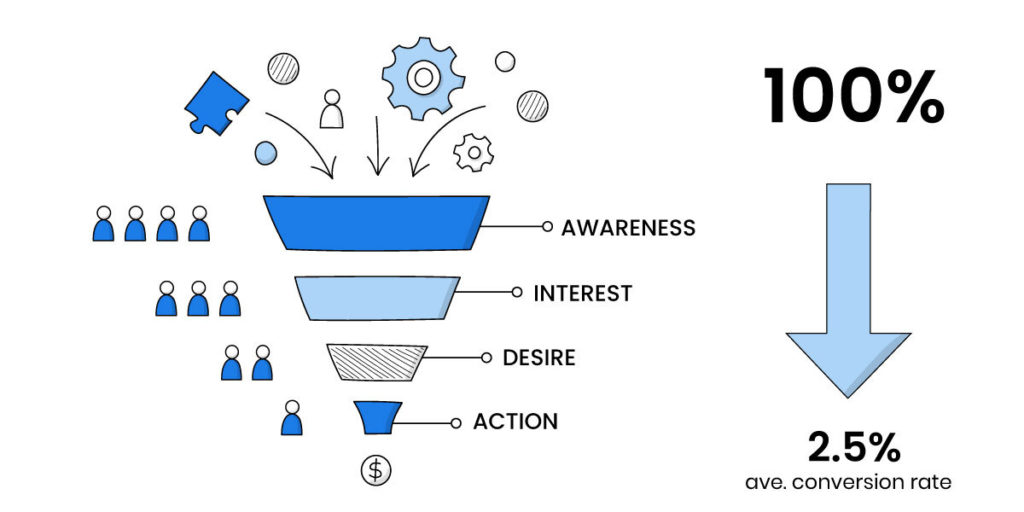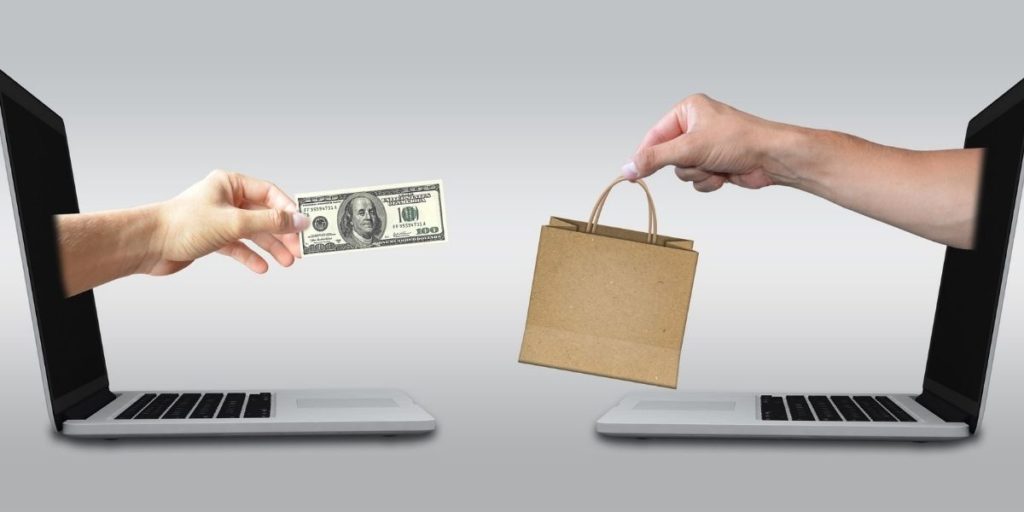
Wouldn’t it be nice if every person visiting your website makes a purchase? Well, we can all dream, can’t we? But unfortunately, a 100% conversion rate is practically impossible, especially among first-time visitors.
Consumers understandably want to get more information about new products and services before adding anything to their cart. They also want to grab the best deals and get the most bang for their buck.
The good news, however, is that by optimizing your ecommerce conversion funnel, you can effectively convert your first-time visitors and potential leads into paying customers.
So, how does a conversion funnel increase your sales? Read until the end to find out!
What is an eCommerce conversion funnel?
Every business uses a unique conversion funnel based on how customers navigate their website. But they all have one thing in common – the funnel demonstrates the path that consumers take from their first ever encounter (top of funnel) right until they make a purchase (bottom of funnel).
The typical funnel has 4-5 stages, with each stage being carefully designed to bring the prospect from the top of the funnel down to the very bottom. The most common is the AIDA model, which stands for Awareness, Interest, Desire, and Action.
The particulars of each funnel depend on the product, service, and audience. Some businesses use a shorter conversion funnel. But this may be because they sell cheaper products, i.e. price isn’t an obstacle, so web visitors convert faster.
Why is a conversion funnel important for your eCommerce store?
You invested a lot of time and money in building your website and sourcing high-quality products. It would be a waste to see all that effort go down the drain because your conversion funnel wasn’t optimized.
Examine your funnel closely and look for areas you can improve on. Determine at which stage of the funnel most of your prospects drop off. You can then come up with an action plan to beef up that weakness, minimize the number of prospects lost at every stage, and maximize sales in the process.
An optimized funnel allows you to improve marketing campaigns that most impact conversion rates. At the same time, it allows you to drive targeted traffic and retain loyal customers.
Let’s say you’re getting a lot of traffic from social media. Take a closer look at the demographics that convert into paying customers. Perhaps you will need to A/B test your call-to-actions to choose the best-performing ones, whether that’s CTA for clicking on your social media post, downloading a lead magnet, or making a purchase.
Keep in mind that your prospects are always on the lookout for better deals. Know who your customers are on a personal level – it’s far easier to encourage them to convert if you know what their problems are.
That said, even the most optimized sales funnels do not have a 100% conversion rate. Here’s a 2020 vs 2021 comparison of ecommerce conversion rate data from IRPCommerce.com.

As you can see, conversion rates for ecommerce stores barely even reached 2.5% in 2020 and 2021. And these are considered good numbers already, so if you can optimize your funnel and go beyond 2.5%, then you’re in excellent territory!
The AIDA Conversion Funnel Stages
At every stage of the AIDA conversion funnel, customers decide on their perceptions of the product, brand, and market competition. It’s therefore important to send the right message at every stage to generate more sales.
Here are tips to optimize each stage of the AIDA ecommerce conversion funnel.
Stage #1 – Awareness
This is arguably the most important part of the funnel because this is the first point of contact between you and potential customers. As the saying goes, first impressions last so it’s important to make a good one right away.
At this stage, they become aware of your existence. You’re still an unknown brand, but an idea is forming in their heads that you may alleviate their pain points or offer a legit solution to their problem. They may know about some of your competitors, but an interesting ad, graphic, or content will keep them keen on checking you out.
So, how do you make people aware of your brand?
Well, this is where buyer personas – or customer avatars – come in. In a nutshell, an avatar is the representation of your target customer. By identifying your target audience, you can create content that will resonate with them and address their pain points.
What are the types of content you can create to build awareness?
There are many different ways to go about this, but the important thing is to NOT SELL right away. You don’t want to come across as a pushy brand, only out to get people’s money!
At this stage, people are keen to know more about you and your brand. So, it’s important to EDUCATE your prospects about what you do and how your product(s) can help them.
Educational content such as guides, reports, webinars, and blog articles are best used in this stage. Disruptive, unexpected, and highly engaging “introductory” types of content bring not just awareness, but also keep their interest levels high!

Stage #2 – Interest
So now you’ve hooked your target audience and they continue to consume your content.
Is it time to sell to them?
Well, the answer is not yet. You may have piqued their interest but they may not be ready to buy from you yet. They’re still checking you out, albeit in a more in-depth manner now that you’ve made to their “shortlist” of brands that can help solve their problem.
What are the types of content that help generate interest in your prospects?
Continue sharing informative and valuable content about your brand and products. Your audience is currently comparing and thinking over their options, so publishing educational blog posts, reports, and articles can help position your brand as an industry expert.
You can also emphasize the features and benefits of your products without doing a hard sell. Product demos and guides can help a lot at this stage and can help your prospects visualize themselves using your products, which builds up their DESIRE to own your product.
Stage #3 – Desire
Now that you’ve captured the interest of your potential customers, it’s time to make them DESIRE or NEED your product.
Position your product as the best option amongst all the different brands they’ve checked out. This is where your unique selling proposition (USP) comes in really handy. As the name suggests, it should be UNIQUE, meaning none of your competitors offer the same thing.
Make your offer so irresistible they’ll regret not taking you up on your offer. Use high-quality product images and/or a video of your product in action.
If you have product reviews and testimonials from other customers, add it here too so they know other people love your products and got great results, too.
Stage #4 – Action

Your leads have come all the way from the top of the funnel (awareness stage) and now they’ve arrived at the final stage. It’s time to seal the deal!
As mentioned earlier in this blog post, a 100% conversion rate is practically impossible. But that doesn’t mean you should settle for the average 2.5%. Strive to do better than everyone else.
You can start by making your call to action clear and actionable. The add-to-cart and checkout process should be simple. Avoid springing unwanted surprises at this stage, e.g. hidden charges, limited payment options, and requesting unnecessary personal details.
Later on, as you collect more data, you can further improve your metrics. You can A/B test on your CTAs, your landing page copy, your sales pages, etc.
Of course, now that you’ve successfully converted your prospects into customers, it doesn’t mean that’s the end of your relationship. Absolutely not! Now that you’ve garnered their trust – and their money – you must continue to nurture your relationship so they will continue to do business with you.
Check out our tips on how to use email marketing for customer retention.
Final thoughts
When done correctly, your ecommerce conversion funnels can provide massive profits for your business. Adapt and/or re-build your funnel from scratch to minimize the number of drop-offs at each stage. It’s crucial to collect data continuously to do this successfully.
One such data-centric tool is Blue Odin. It gives you a bird’s eye view of your store’s key metrics and KPIs, meaning you have all the data you need to improve your ecommerce conversion funnel.








